In this post, we will see how to manage a SQLite database with Python.
But first of all, what is SQLite?
“SQLite is a lightweight, file-based relational database management system that is widely used due to its simplicity, portability, and ease of integration into various programming languages.
It provides a self-contained, serverless, and zero-configuration architecture, making it an excellent choice for small to medium-sized applications and projects.
SQLite differs from traditional client-server databases in that the entire database is contained within a single file, making it easy to distribute, copy, or backup. It stores data in a structured manner, allowing us to define tables, columns, and relationships similar to other relational databases.”
For all information, we can go the the official website: www.sqlite.org.
One of the significant advantages of SQLite, is its seamless integration with programming languages like Python. The Python Standard Library includes the sqlite3 module, which provides a convenient and intuitive way to interact with SQLite databases.
For this post, we are going to create a class called “CoreSQLite” that we will use to manage all the CRUD operations for a table called “TabUser” created in a DB called “UserDb”
CHECKING DB:
1 2 3 4 5 6 7 8 9 10 11 12 13 14 15 16 17 18 19 20 21 22 23 24 25 26 27 28 29 30 31 32 33 34 35 36 37 38 39 | import sqlite3import osclass CoreSQLite: connection = None def __init__(self, dbName): self.dbName = dbName self.dbFileName = dbName + '.db' self.checkDB() def checkDB(self): # Get the current working directory working_dir = os.getcwd() # Construct the full path to the database file checkDbFile = os.path.join(working_dir, self.dbFileName) # checking the existence of the database if not os.path.exists(checkDbFile): # Create the database file by opening a connection self.connection = sqlite3.connect( 'file:' + checkDbFile + '?mode=rwc', uri=True) # Create the TabUser table self._createTabUser() # Close the connection self.connection.close() print( f"SQLite database file '{self.dbFileName}' created successfully.") else: print(f"SQLite database file '{self.dbFileName}' already exists.") def _createTabUser(self): # Create a cursor object to execute SQL statements cursor = self.connection.cursor() # Create the TabUser table with columns Id, Username, and Password cursor.execute( 'CREATE TABLE TabUser (Id INTEGER PRIMARY KEY AUTOINCREMENT, Username TEXT(250),Password TEXT(20))') self.connection.commit() cursor.close() |
[MAIN.PY]
1 2 3 | from CoreSQLite import CoreSQLiteobjDb = CoreSQLite('UserDb') |
If we run the main.py file, the following will be the result:
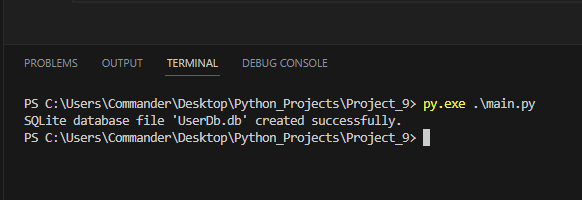
Using a tool like DBeaver, we can check if the table TabUser has been created in the database:
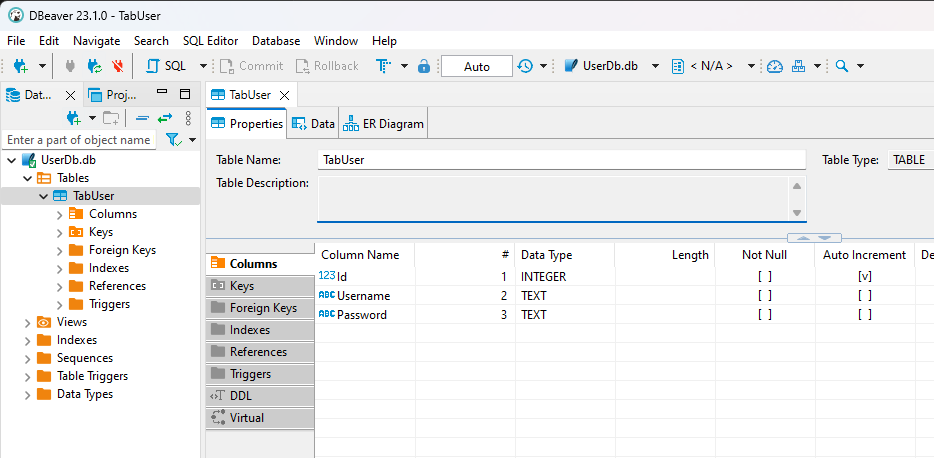
INSERTING A NEW USER:
1 2 3 4 5 6 7 8 9 10 11 12 13 14 15 16 17 18 19 20 21 22 23 24 25 26 27 28 29 30 31 32 33 34 35 | import sqlite3import osclass CoreSQLite: connection = None cursor = None def __init__(self, dbName): self.dbName = dbName self.dbFileName = dbName + '.db' self.checkDB() def checkDB(self): ... def _createTabUser(self): ... def _openCursor(self): # Get the current working directory working_dir = os.getcwd() # Construct the full path to the database file dbFile = os.path.join(working_dir, self.dbFileName) self.connection = sqlite3.connect(dbFile) self.cursor = self.connection.cursor() # Create (Insert) operation def create_user(self, userName, password): self._openCursor() self.cursor.execute( 'INSERT INTO TabUser (username, password) VALUES (?, ?)', (userName, password)) self.connection.commit() self.cursor.close() # Close the connection self.connection.close() print(f"User {userName} {password} created successfully.") |
[MAIN.PY]
1 2 3 4 5 6 7 | from CoreSQLite import CoreSQLiteobjDb = CoreSQLite('UserDb')# creating 20 usersfor i in range(1, 20): objDb.create_user(f"User{i}", f"Pass123_{i}") |
If we run the main.py file, the following will be the result:
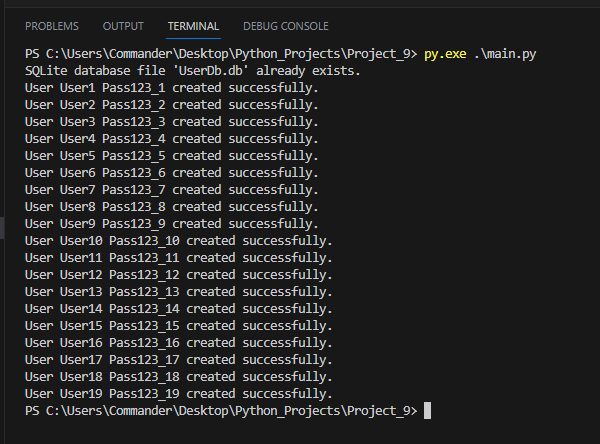
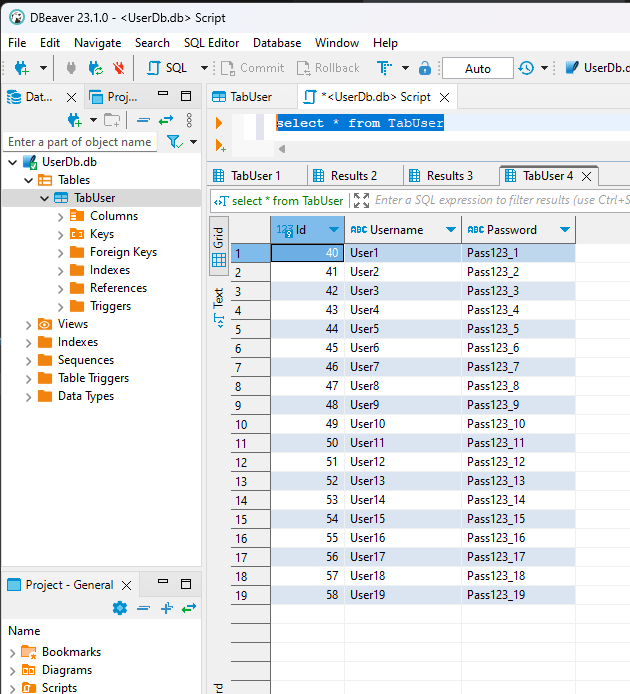
SELECTING ALL USERS:
1 2 3 4 5 6 7 8 9 10 11 12 13 14 15 16 17 18 19 20 21 22 23 24 25 26 27 28 29 | import sqlite3import osclass CoreSQLite: connection = None cursor = None def __init__(self, dbName): ... def checkDB(self): ... def _createTabUser(self): ... def _openCursor(self): ... # Create (Insert) operation def create_user(self, userName, password): ... # Read operation def get_users(self): self._openCursor() self.cursor.execute('SELECT * FROM TabUser') rows = self.cursor.fetchall() self.cursor.close() # Close the connection self.connection.close() for row in rows: print(f"ID: {row[0]}, UserName: {row[1]}, Password: {row[2]}") |
[MAIN.PY]
1 2 3 4 5 | from CoreSQLite import CoreSQLiteobjDb = CoreSQLite('UserDb')objDb.get_users() |
If we run the main.py file, the following will be the result:
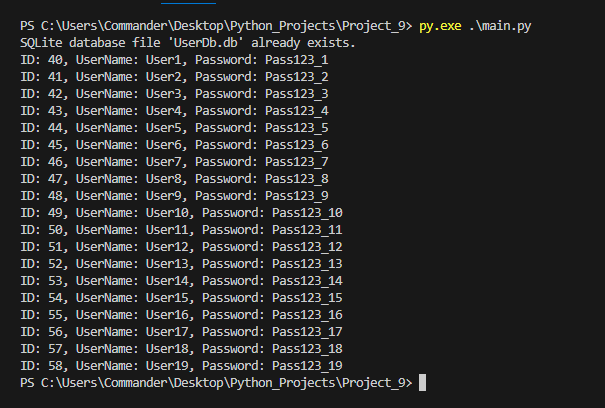
UPDATING AN USER:
1 2 3 4 5 6 7 8 9 10 11 12 13 14 15 16 17 18 19 20 21 22 23 24 25 26 27 28 29 30 31 32 | import sqlite3import osclass CoreSQLite: connection = None cursor = None def __init__(self, dbName): ... def checkDB(self): ... def _createTabUser(self): ... def _openCursor(self): ... # Create (Insert) operation def create_user(self, userName, password): ... # Read operation def get_users(self): ... # Update operation def update_user(self, id, username, password): self._openCursor() self.cursor.execute( 'UPDATE TabUser SET username = ?, password = ? WHERE id = ?', (username, password, id)) self.connection.commit() self.cursor.close() # Close the connection self.connection.close() print("User updated successfully.") |
[MAIN.PY]
1 2 3 4 5 6 7 8 9 10 11 12 13 14 15 | from CoreSQLite import CoreSQLiteobjDb = CoreSQLite('UserDb')# Create an UserobjDb.create_user('DamianoUser', 'Pass123')# Select UsersobjDb.get_users()# update UserobjDb.update_user(1, 'UpdateDamianoUser', 'UpdatePass123')# Select UsersobjDb.get_users() |
If we run the main.py file, the following will be the result:

DELETING AN USER:
1 2 3 4 5 6 7 8 9 10 11 12 13 14 15 16 17 18 19 20 21 22 23 24 25 26 27 28 29 30 31 32 | import sqlite3import osclass CoreSQLite: connection = None cursor = None def __init__(self, dbName): ... def checkDB(self): ... def _openCursor(self): ... # Create (Insert) operation def create_user(self, userName, password): ... # Read operation def get_users(self): ... # Update operation def update_user(self, id, username, password): ... # Delete operation def delete_user(self, id): self._openCursor() self.cursor.execute('DELETE FROM TabUser WHERE id = ?', (id,)) self.connection.commit() self.cursor.close() # Close the connection self.connection.close() print("User deleted successfully.") |
[MAIN.PY]
1 2 3 4 5 6 7 8 9 10 11 12 13 14 15 | from CoreSQLite import CoreSQLiteobjDb = CoreSQLite('UserDb')# Create an UserobjDb.create_user('DamianoUser', 'Pass123')# Select UsersobjDb.get_users()# Delete UserobjDb.delete_user(1)# Select UsersobjDb.get_users() |
If we run the main.py file, the following will be the result:

[CORESQLITE.PY]
1 2 3 4 5 6 7 8 9 10 11 12 13 14 15 16 17 18 19 20 21 22 23 24 25 26 27 28 29 30 31 32 33 34 35 36 37 38 39 40 41 42 43 44 45 46 47 48 49 50 51 52 53 54 55 56 57 58 59 60 61 62 63 64 65 66 67 68 69 70 71 72 73 74 75 76 77 78 79 80 81 82 83 84 85 86 87 88 89 90 91 | import sqlite3import osclass CoreSQLite: connection = None cursor = None def __init__(self, dbName): self.dbName = dbName self.dbFileName = dbName + '.db' self.checkDB() def checkDB(self): # Get the current working directory working_dir = os.getcwd() # Construct the full path to the database file checkDbFile = os.path.join(working_dir, self.dbFileName) # checking the existence of the database if not os.path.exists(checkDbFile): # Create the database file by opening a connection self.connection = sqlite3.connect( 'file:' + checkDbFile + '?mode=rwc', uri=True) # Create the TabUser table self._createTabUser() # Close the connection self.connection.close() print( f"SQLite database file '{self.dbFileName}' created successfully.") else: print(f"SQLite database file '{self.dbFileName}' already exists.") def _createTabUser(self): # Create a cursor object to execute SQL statements cursor = self.connection.cursor() # Create the TabUser table with columns Id, Username, and Password cursor.execute( 'CREATE TABLE TabUser (Id INTEGER PRIMARY KEY AUTOINCREMENT, Username TEXT(250),Password TEXT(20))') self.connection.commit() cursor.close() def _openCursor(self): # Get the current working directory working_dir = os.getcwd() # Construct the full path to the database file dbFile = os.path.join(working_dir, self.dbFileName) self.connection = sqlite3.connect(dbFile) self.cursor = self.connection.cursor() # Create (Insert) operation def create_user(self, userName, password): self._openCursor() self.cursor.execute( 'INSERT INTO TabUser (username, password) VALUES (?, ?)', (userName, password)) self.connection.commit() self.cursor.close() # Close the connection self.connection.close() print(f"User {userName} {password} created successfully.") # Read operation def get_users(self): self._openCursor() self.cursor.execute('SELECT * FROM TabUser') rows = self.cursor.fetchall() self.cursor.close() # Close the connection self.connection.close() for row in rows: print(f"ID: {row[0]}, UserName: {row[1]}, Password: {row[2]}") # Update operation def update_user(self, id, username, password): self._openCursor() self.cursor.execute( 'UPDATE TabUser SET username = ?, password = ? WHERE id = ?', (username, password, id)) self.connection.commit() self.cursor.close() # Close the connection self.connection.close() print("User updated successfully.") # Delete operation def delete_user(self, id): self._openCursor() self.cursor.execute('DELETE FROM TabUser WHERE id = ?', (id,)) self.connection.commit() self.cursor.close() # Close the connection self.connection.close() print("User deleted successfully.") |